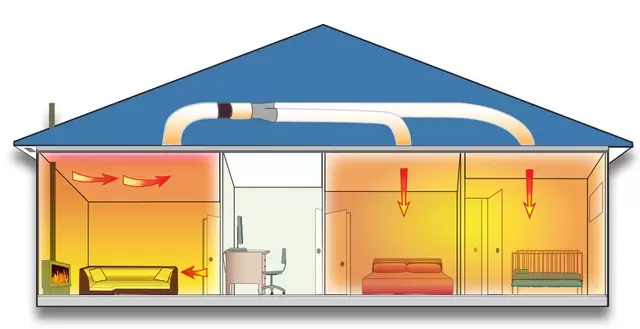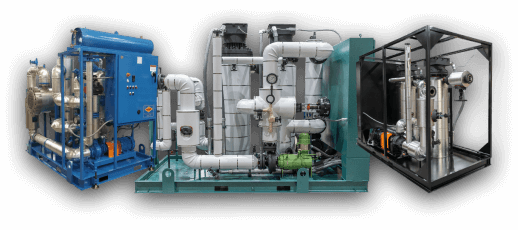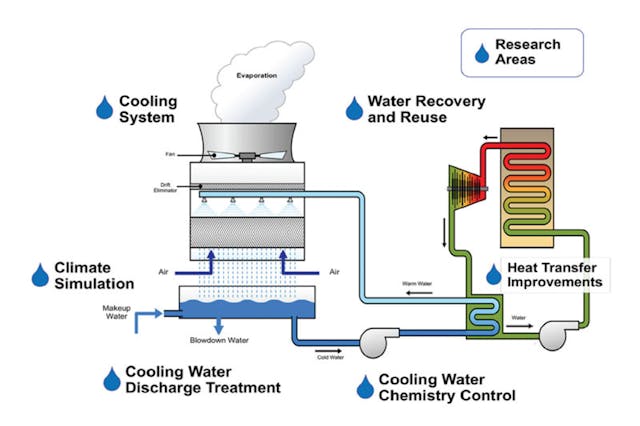DVS Heat Transfer Systems: The Future of Energy-Efficient Industrial Heating Solutions
Wiki Article
A Comprehensive Overview to Choosing the Right Heat Transfer Systems for Your Needs
Selecting the suitable Heat transfer system is important for functional effectiveness. Various systems cater to different needs, affected by aspects such as temperature level variety and liquid type. Comprehending the principles behind Heat transfer, such as convection, radiation, and transmission, is crucial. In addition, reviewing energy resources and maintenance methods can impact long-lasting efficiency. A closer exam of these considerations reveals exactly how to tailor a system to specific demands. What should one prioritize in this complicated decision-making procedure?Recognizing Heat Transfer: Key Ideas and Principles
Heat transfer may seem like an uncomplicated principle, it includes an array of concepts that are basic for effective system layout - DVS Heat Transfer Systems. Comprehending these concepts is vital for engineers and developers who intend to enhance thermal performance in different applications. Conduction, for example, involves the transfer of Heat through solid products, while convection refers to the movement of Heat within liquids. Radiation, an additional key principle, explains how Heat can be moved via electromagnetic waves. Each of these systems plays an important duty in determining how energy moves within a system. By completely grasping these ideas, experts can make informed choices, making certain that Heat transfer systems run effectively and satisfy the certain demands of their applications
Sorts Of Heat Transfer Solutions: An Overview
Understanding the principles of Heat transfer prepares for discovering the numerous kinds of Heat transfer systems available. Heat transfer systems can be classified mainly into 3 types: radiation, convection, and transmission. Transmission includes Heat transfer via solid materials, depending on direct contact in between bits. Convection, on the various other hand, happens in liquids (gases and liquids) where the activity of the liquid itself facilitates Heat transfer. Radiation includes the transfer of Heat via electro-magnetic waves and does not call for a medium, allowing it to take place in a vacuum cleaner. Each kind of system has unique features and applications, making it essential for people and organizations to very carefully evaluate their details demands when choosing one of the most suitable Heat transfer service.Applications of Heat Transfer Equipments in Numerous Industries
Heat transfer systems play an essential function across different industries, influencing effectiveness and item high quality. In commercial manufacturing processes, they help with specific temperature control, while in food and drink handling, they guarantee safety and conservation. Additionally, HVAC and climate control systems rely heavily on reliable Heat transfer to keep comfortable environments.Industrial Manufacturing Processes

Various industrial manufacturing processes depend greatly on effective Heat transfer systems to optimize productivity and improve item top quality. In sectors such as metalworking, Heat exchangers play an essential duty in preserving suitable temperatures throughout welding, spreading, and forging. These systems guarantee consistent Heat circulation, which is crucial for achieving preferred material homes. In the chemical manufacturing market, Heat transfer systems facilitate precise temperature control during responses, influencing return and safety and security. Additionally, in textile manufacturing, efficient Heat management is very important for dyeing and ending up procedures, influencing color uniformity and textile top quality. By picking suitable Heat transfer modern technologies, manufacturers can improve power effectiveness and reduce functional expenses, ultimately leading to an extra lasting and competitive production environment.
Food and Drink Processing
Reliable Heat transfer systems are equally vital in the food and drink processing industry, where preserving optimal temperatures is important for food security and quality. These systems play an important function in processes such as pasteurization, sanitation, and food preparation, guaranteeing that items are risk-free for intake and retain their dietary value. Heat exchangers, as an example, efficiently move Heat in between fluids, optimizing energy usage while minimizing temperature fluctuations. Furthermore, refrigeration systems are basic for preserving subject to spoiling products and prolonging life span. The option of Heat transfer technology directly influences operational effectiveness and item honesty, making it important for food and beverage producers to pick the appropriate systems tailored to their details handling needs. This careful selection inevitably adds to consumer fulfillment and food safety and security.
Cooling And Heating and Environment Control
While numerous sectors rely upon Heat transfer systems for efficiency, HEATING AND COOLING (Home Heating, Air Flow, and A/c) plays an important duty in preserving indoor climate control across different settings. These systems use Heat transfer concepts to manage humidity, air, and temperature high quality, making certain comfort and safety and security in household, commercial, and commercial settings. Appropriately created heating and cooling systems boost power efficiency, minimize functional costs, and decrease ecological influence. In commercial buildings, as an example, effective climate control adds to employee performance and client complete satisfaction. In industrial applications, HVAC systems help preserve suitable problems for equipment operation and product preservation. Selecting the best Heat transfer system is vital for meeting particular climate control demands and attaining overall system efficiency.Evaluating Power Resources for Heat Transfer Systems
In examining power sources for Heat transfer systems, a comparison of renewable resource options and fossil fuel considerations is necessary. Sustainable sources, such as solar and wind, offer lasting alternatives that can lower ecological impact. On the other hand, fossil fuels stay widespread due to their well established framework and power thickness, motivating a mindful evaluation of both choices.Renewable Power Options

Fossil Fuel Considerations
Assessing nonrenewable fuel source considerations is crucial for the performance and sustainability of Heat transfer systems. Nonrenewable fuel sources, such as all-natural gas, oil, and coal, are typical energy sources that provide considerable Heat result, making them popular options for commercial and household applications. However, their ecological influence, consisting of greenhouse gas exhausts and source deficiency, elevates concerns. When selecting a warmth transfer system, it is vital to examine the schedule, price, and regulative elements related to these Get More Info fuels. Furthermore, the efficiency of fossil gas systems should be considered, as greater effectiveness can reduce some ecological downsides. Ultimately, a balanced strategy evaluating efficiency and sustainability can direct decision-makers toward the most proper Heat transfer solution for their details requirements.Variables to Consider When Selecting a Warmth Transfer System
Choosing an appropriate Heat transfer system requires careful consideration of various elements that can considerably influence efficiency and efficiency. One crucial aspect is the operating temperature array, which determines the products and design ideal for the application. Furthermore, the kind of liquid used in the system-- whether gas or liquid-- impacts Heat transfer efficiency and compatibility. The system's dimension and ability must straighten with the particular demands of the operation to prevent inefficiencies. Energy source availability is additionally crucial, influencing operating expenses and sustainability. The installment atmosphere, including room restraints and accessibility for maintenance, plays a significant duty in system choice. Governing compliance and safety requirements should be thought about to guarantee the system fulfills all legal requirements.Upkeep and Efficiency Optimization for Heat Transfer Equipments
Preserving Heat transfer systems is important for making sure optimal efficiency and long life. Normal maintenance activities, such as cleansing Heat exchangers and inspecting insulation, assistance avoid efficiency losses due to fouling and thermal connecting. Furthermore, monitoring system specifications, consisting of stress and temperature, enables very early detection of abnormalities, decreasing downtime and costly repair services. Carrying out a precautionary maintenance timetable can optimize efficiency and extend the life-span of components. Furthermore, updating to innovative control systems can boost functional efficiency by adapting to varying conditions and lots. By focusing on maintenance and performance optimization, drivers can attain lowered energy usage, reduced functional expenses, and boosted total system reliability, eventually causing much better resource usage and a explanation much more sustainable operation.Future Fads in Heat Transfer Technologies
As markets significantly focus on sustainability and energy performance, future patterns in Heat transfer technologies are readied to go through considerable makeovers. Technologies such as sophisticated products, including carbon nanotubes and nanofluids, promise improved thermal conductivity and effectiveness. Additionally, the assimilation of renewable resource sources into Heat transfer systems is gaining momentum, promoting green solutions. Smart innovations, consisting of IoT sensors, are anticipated to revolutionize tracking and control, making it possible for real-time information evaluation for enhanced efficiency. In addition, the growth of small and modular systems will certainly facilitate easier installation and maintenance, satisfying varied applications. These innovations indicate a shift in the direction of even more lasting, reliable, and adaptable Heat transfer services, lining up with global energy objectives and environmental requirements.
Frequently Asked Concerns
What Are the Ecological Impacts of Heat Transfer Solutions?
The environmental impacts of Heat transfer systems can include greenhouse gas emissions, power intake, and prospective thermal air pollution. Furthermore, inappropriate disposal of materials and inadequacies can add to source exhaustion and environment interruption.Exactly how Do I Calculate the Cost-Effectiveness of a Warm Transfer System?
To compute the cost-effectiveness of a warmth transfer system, one should examine first expenses, functional expenses, upkeep demands, and power effectiveness, contrasting these variables versus the expected life expectancy and efficiency of the system.Can Heat Transfer Systems Be Used in Residential Setups?
Heat transfer systems can without a doubt be made use of in residential setups. They give efficient home heating and cooling down solutions, making homes extra comfy while potentially reducing energy costs. Their adaptability permits different applications in household environments.What Safety Regulations Apply to Heat Transfer Solutions?
Safety and security policies for Heat transfer systems commonly include guidelines you can try this out on installment, maintenance, and procedure. Conformity with local building ordinance, manufacturer requirements, and industry standards is vital to ensure reliable and risk-free system efficiency in various applications.Exactly How Do Different Materials Affect Heat Transfer Effectiveness?

Transmission, for circumstances, involves the transfer of Heat through solid materials, while convection refers to the motion of Heat within liquids. Comprehending the concepts of Heat transfer lays the groundwork for exploring the different types of Heat transfer systems offered. Heat exchangers, for instance, efficiently transfer Heat between fluids, enhancing energy usage while reducing temperature variations. In evaluating power sources for Heat transfer systems, a comparison of eco-friendly power alternatives and fossil gas factors to consider is vital. Steels, such as copper and light weight aluminum, conduct Heat efficiently, whereas insulators like rubber and glass reduce down Heat circulation.
Report this wiki page